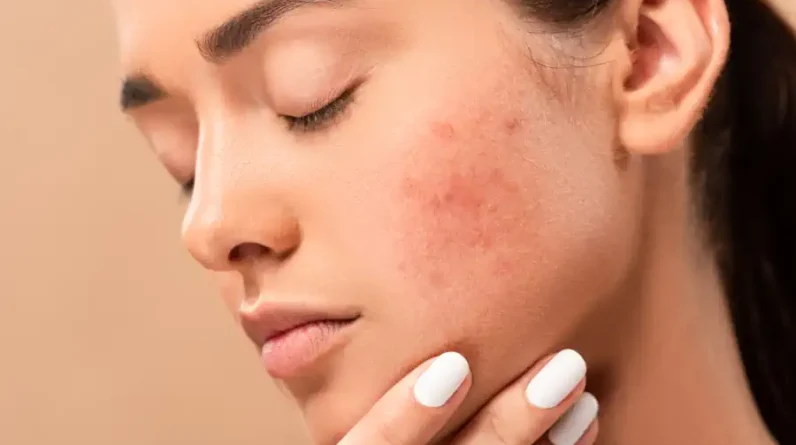Winter can be tough on the skin. Acne breakouts can be more severe in the winter than in the summer. The dry weather, indoor heaters, and other factors can all dry the skin and contribute to more serious acne breakouts. In the winter, is important to take extra steps to keep skin clean and free from oily buildup.

What Is Winter Acne?
“Winter acne” is simply the type of acne that often appears in the colder winter months. It shares many similarities with other forms of acne, such as clogged pores and inflammation, but tends to be more severe due to the addition of cold temperatures, low humidity levels, harsh winds, and heavy clothing trapping heat and sweat close to the skin. Winter acne can also take on different characteristics than other types of acne – for example, it may appear in smaller clusters or look redder due to a lack of hydration.
What Causes Winter Acne?
Cold weather, wind, rain, snow, and lack of humidity can all strip moisture from the skin. When skin is dry, it produces more sebum oil which can cause more acne breakouts. Heaters and hotter showers indoors also make the skin’s protective barrier more likely to become damaged, leading to inflammation and irritation. It weakens the skin’s ability to fight off bacterial infections and can cause flaking, which can clog pores. Dry skin makes it easier for pores to become clogged, too.
The weather, the environment, and even the holidays can cause acne breakouts to become more frequent or severe during the winter. Changes in diet, added stress, and less consistency with skincare routines from holiday celebrations can also make it worse for those with acne-prone skin.
Who Gets Winter Acne?
People who have acne-prone skin are more likely to experience winter acne breakouts, but even those without acne can be affected by the dry winter weather. Everyone should take steps to keep their skin hydrated and healthy to minimize the risk of breakouts.
Winter acne is most common on the face, particularly the T-Zone (forehead, nose, and chin). It can also appear on other parts of the body such as the shoulders, chest, back, neck and arms. Even those who don’t usually have acne may experience winter acne flare-ups on their faces and other areas.
Preventing Winter Acne
If you have acne-prone skin, talk to your dermatologist and create a plan to prevent winter breakouts. For those who don’t typically have acne, take steps to address it when you first notice breakouts.
Paying close attention to your skincare routine during this time can help you avoid or treat any breakouts which may arise. As the temperature becomes colder, you may need to make adjustments to your skincare routine, in order to keep winter acne at bay. You will want to use caution while using skin-drying, acne-fighting treatments, since they may aggravate winter acne.

Use a Gentle Facial Cleanser
During the wintertime, you don’t need to clean your skin as often. Overcleaning can make breakouts worse, so only wash your face twice a day and take baths or showers less frequently. Look for a gentle facial cleanser that’s recommended for sensitive skin to avoid irritation. Consider switching from a foaming to a cream cleanser as well.
Apply Extra Layers of Moisturizers
For an effective wintertime acne skin care routine, start with using multiple layers of lighter oil-free and non-comedogenic moisturizers with ingredients like hyaluronic, glycolic, and lactic acid. These humectants help draw moisture into the skin and prevent breakouts.
Apply the moisturizer immediately after washing your face and at the end of your daily skin care routine. This will help to trap in moisture from the water and soothe irritation. Additionally, apply moisturizer to your face and body any time you take a bath or shower.

Exfoliate
Exfoliating with a gentle retinol or salicylic acid can help reduce the thicker, flaky skin caused by dryness and the risk of breakouts. Be sure to moisturize afterwards.
Apply Sunscreen, Even in the Winter
Apply sunscreen every day, even when it’s cold outside. Choose a broad-spectrum sunscreen with an SPF of 30 or higher to protect your skin and prevent acne breakouts.
Avoid Touching Your Skin or Picking at Blemishes
Avoid touching your face or affected areas when you have a breakout. Picking at the skin or popping blemishes can increase irritation and inflammation and make infection more likely. Try to avoid touching your skin when you have a breakout to prevent bacteria, grease, and other irritants from transferring onto the skin.
Use Products with Certain Ingredients Sparingly
Ingredients like salicylic acid and benzoyl peroxide are often found in acne-fighting skin care products. However, these ingredients can strip away moisture, so use them sparingly during the wintertime. If you have an active breakout, switch to spot treatments and apply only a small amount directly to blemishes.
Many people have difficulty keeping their skin clear during the winter months when dryness may lead to more severe outbreaks. Humidity levels and temperatures below freezing can increase the chances of getting winter acne. If your skincare routine isn’t helping to prevent winter breakouts, it’s time to talk to a dermatologist. They can help you find better skincare products, adjust your daily care routine, or offer in-office treatments.







